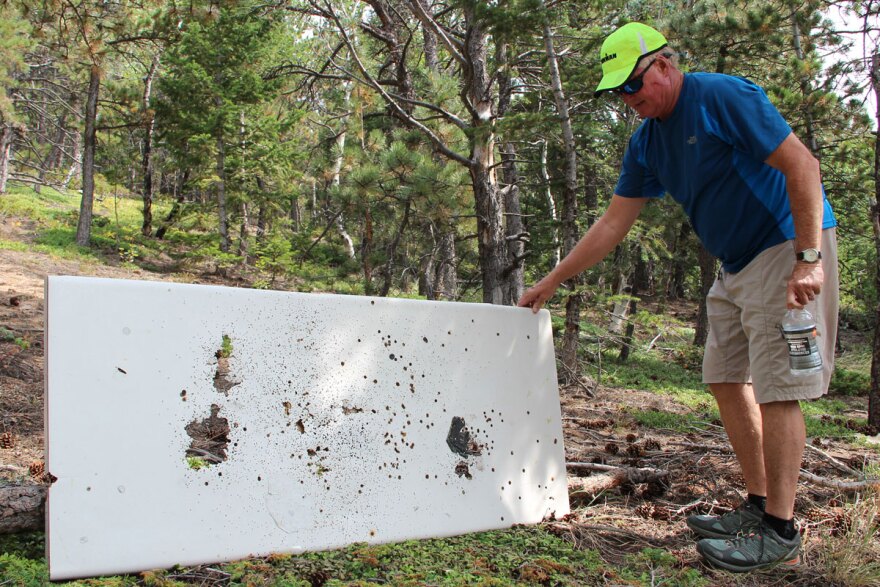Andrea Sedlmayr has lived in the mountains west of Boulder for four decades. She’s used to hearing hunters and the occasional gunshots around her house. But about five years ago, things started to change.
She and her husband would be eating dinner or sitting outside reading the paper Sunday mornings, and “suddenly it’s pow, pow-pow-pow,” Sedlmayr said.
The popping sounds were gunshots. Sedlmayr and thousands of other residents who live in the foothills outside towns like Boulder, Lyons, and even Fort Collins, say the rise and near omnipresence of recreational shooting in the area has completely changed the character -- and the safety -- of where they live.

Shooting in the national forest isn’t new. But it is growing in popularity as Colorado’s Front Range population grows, said Josh Milligan, a planner with the Arapaho Roosevelt National Forest. That, coupled with the spread of homes into the private land that checkers the forest along the foothills, is leading to conflicts. In July, a camper in the Pike National Forest outside Colorado Springs was killed by a stray bullet.
There haven’t been any injuries here yet, said Milligan. Officials with the Arapaho Roosevelt National Forest want to keep it that way. That's why they have proposed the first ever forest-wide plan to limit recreational shooting.
“It’s something we’d like to see happening on the forest but in a way that maintains public safety,” Milligan said.
To draw the limits, agency staff looked at where people live and recreate, and drew a buffer around the areas where conflict is likely. The result is a proposal to ban recreational shooting on about 20 percent of the forest’s 1.4 million acres, primarily in the corridor running along the Front Range foothills. Most of the area proposed for closure runs along the foothills roughly from just above Hwy. 34 south to just above I-70, and along the Poudre River corridor.

Forest planners, including Milligan, realize this will remove a lot of land that people currently use for shooting, so they’ve offered a trade of sorts. In exchange for limits on recreational shooting in areas near people, they will build public shooting ranges that are easily accessible.
That may not be a good enough solution for folks like Justin King, a Boy Scout troop leader that attended a recent open house on the proposal. King leads a troop out of Loveland and takes large groups of scouts into the woods to learn how to shoot safely. He was disappointed by the proposal, calling it “too aggressive.”
King’s main worry is that by closing off most of the land in the foothills, where public and private lands are interspersed, he and the scouts are left without a place to go shoot nearby. Private ranges are expensive, and not the same experience as a camp out, he pointed out.
If you don’t live near a national forest, it might be hard to understand the scale of shooting taking place. About a mile above Andrea Sedlmayr’s neighborhood in Boulder County is the Switzerland Trail, a four-wheel drive road popular with hikers, mountain bikers, and dirt bikers as well as vehicles.

Walking just a bit off the trail, Sedlmayr’s husband, John Mahoney, encounters pieces of clay pigeons and shells of all calibers. He carries a garbage bag and fills it as he walks. Shooting debris along with cans, bottles and larger pieces of trash are scattered over the forest. Large trees drip with sap after being used for target practice. Others have bullet holes that pierce through the entire tree, so you can see through to the other side. Other neighbors say they have found entire trees destroyed, split in half from target shooting.
Looking to the west, it’s easy to see how a shooter might feel isolated enough to pop off a few rounds. But the area is just 10 miles west of Boulder. In the valleys and canyons below sit hundreds of homes. Mahoney recalled a day a few years back when he rode his mountain bike, unwittingly, in front of several shooters. He heard the fire and yelled “rider, rider,” but it didn’t stop. Then he crested a hill and saw them.

“So I don’t ride that way anymore,” he said.
It is currently illegal to shoot within 150 yards of a structure and in a way that could harm people, property, or resources on a national forest. Those opposed to closing more of the forest say the Forest Service needs to simply enforce those rules, not impose new ones.
But until this section of the Arapaho Roosevelt National Forest was closed to shooting in May 2015 -- after complaints from residents -- Sedlmayr and her husband, as well as others who live in the neighborhood, said they did not feel safe. Today, the noise of shooters just outside the closed area pops off every 10 or 20 seconds while Mahoney and Seldmayr walk around.
Josh Milligan, the forest planner, also said that the existing rules, which can be interpreted very broadly, may not be providing the protection needed around private residences. That’s why a forest-wide plan is necessary, he said.
The current proposal is open for comments until Saturday, Sept. 19. After that the forest will release a more formal plan and accept public comment, said Milligan.
Sedlmayr knows the whole process may take a while, but she believes closures are necessary to maintain public safety. She makes clear she's not opposed to guns or even recreational shooting, but it needs to take place further from where people live.
“My feeling is, if they close the area that they are proposing to close, we would be free again to walk again, and hike and camp and bike and do everything we want to do here.”






